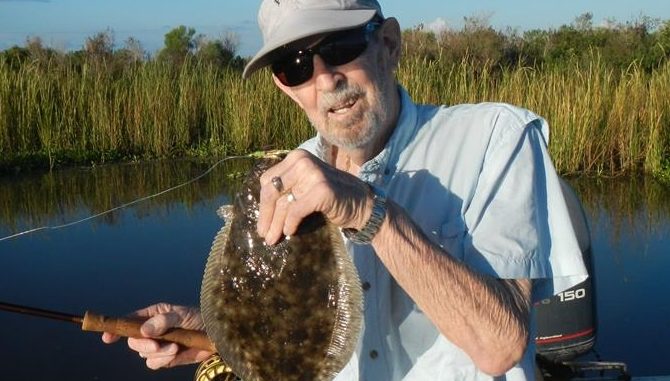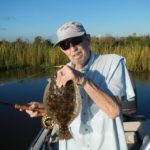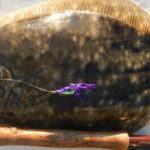
The late author’s tactics for fall flounder
This month, we continue our tribute to Louisiana’s fly fishing legend, the late Pete Cooper Jr., by focusing on a particular species dear to his heart — flounder.
Flounder are tough to catch — just ask any kayaker who has fished a slam tournament. It’s very rare that even 10 percent of the participants weigh in a flatfish.
I’ve caught a lot of flatties on flies. But considering I’ve been flyrodding the marsh for 30 years, my average is pretty measly — about three per year. Almost all are caught while flycasting for specks.
That’s where Pete started with his quest for flounder. He called them “unintentional” catches while chasing trout.
But his passion for Mr. Flatface led him to study their life cycle and habits. Soon he was catching as many in one trip as some of us catch in a year.
That knowledge got a boost when he was appointed to a committee of the Gulf State Marine Fisheries Commission to develop a coast-wide flounder management plan. Some of the data presented to the committee turned out to be quite beneficial to Pete’s cause.
Flounder are scattered across the estuary most of the summer and early fall. But when there’s a sharp drop in the water temperature — usually late November — they begin to cluster in large numbers to head offshore.
While on their way to offshore spawning areas, they’ll gather to feed along tidal cuts in marshes or along the edges of islands.
According to Pete, the fish are looking for current to bring prey to them. They’ll lay on the down-current side of a dropoff, often just as it begins to shallow.
Pete called these “vertical traps.” If you look at the dark water of a cut, then see where it gets lighter, that’s the area of the trap. Prey are swept through the cut, then pushed upwards as the cut gets wider and shallows off.
Looking for baitfish activity is the key to every flyrodder’s success. As Pete noted, this is especially true when searching for flounder. On many occasions, Pete observed them completely flipping out the water while busting minnows.
The typical marsh outfit — 7 or 8-weight rod with floating line — works just fine for a doormat. However, Pete cautioned that the leader should have a “bite tippet” of 20 or 30-pound fluorocarbon. Without it, their sharp teeth can fray the tippet.
Matching the hatch requires baitfish patterns. Pete’s favorite fly for his flat friends was a lightly weighted Clouser Minnow in size 1 in either “mullet” colors or in white (imitating white shrimp).
However, there were times when purple was the right choice. This was often when there were an abundance of killifish, a.k.a. storm minnows. Or in early December when water clarity was at its peak and baitfish had a more subdued coloration.
The technique Pete used to present the fly was as follows: He would anchor off to the side of the cut. The cast would be made cross-current just above the lip of the cut. Then the fly would be stripped slowly in as it was being swept by the current.
It’s important to note that the retrieve not be too slow. The fly should not drag the bottom. Flounder will rise to prey, sometimes even to the surface.
Pete also noted that if a flatfish strikes your fly but misses, wait a couple minutes and try that spot again. Most likely that fish has settled back to its original spot and will strike again.
Some years back, I told Pete that most of my flounder were caught working a Clouser suspended under a Vertical Oriented Strike Indicator (VOSI). The VOSI is the fly rodder’s popping cork, and very effective for speckled trout. I asked if he’d ever tried Clousers under a VOSI.
He pointed out that the changing bathymetry of a tidal cut, or even a tidal shoreline, required that the fly be presented at different depths at different times, sometimes even in one presentation.
“How do you change the depth of the suspended fly while you’re retrieving it?” he asked. I didn’t have an answer. Touché, Pete.
One thing Pete noted about flounder that I’ve learned the hard way: When the fish eats, it’s often a much more subtle strike than a speck or red.
As he suggests, “If you notice a sudden drag in your line, it’s better to set the hook on suspicion than not setting it at all.”
Pete summarized the flounder fishing experience best when he noted that, while you can’t stalk them like redfish or enjoy topwater action like with specks, they’re a challenge — fun to catch and great at the dinner table.
If you want to know more about flounder on the fly, there’s a whole chapter dedicated to it in Pete’s book, “Fly Fishing the Louisiana Coast” available at many fly shops and bookstores.




